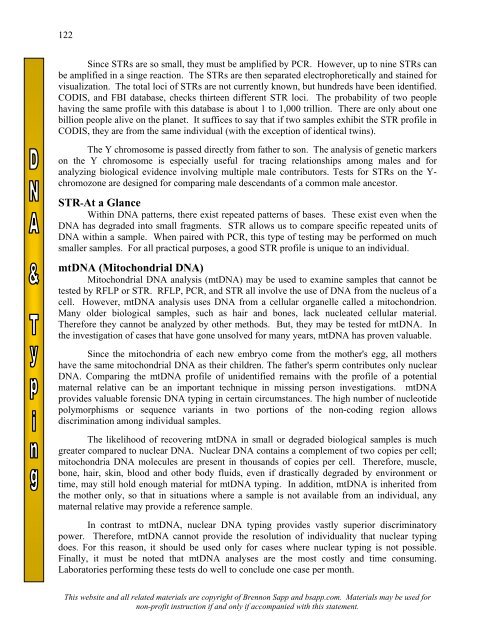DNA & Typing - Sapp's Instructional Websites
DNA & Typing - Sapp's Instructional Websites
DNA & Typing - Sapp's Instructional Websites
Create successful ePaper yourself
Turn your PDF publications into a flip-book with our unique Google optimized e-Paper software.
122<br />
Since STRs are so small, they must be amplified by PCR. However, up to nine STRs can<br />
be amplified in a singe reaction. The STRs are then separated electrophoretically and stained for<br />
visualization. The total loci of STRs are not currently known, but hundreds have been identified.<br />
CODIS, and FBI database, checks thirteen different STR loci. The probability of two people<br />
having the same profile with this database is about 1 to 1,000 trillion. There are only about one<br />
billion people alive on the planet. It suffices to say that if two samples exhibit the STR profile in<br />
CODIS, they are from the same individual (with the exception of identical twins).<br />
The Y chromosome is passed directly from father to son. The analysis of genetic markers<br />
on the Y chromosome is especially useful for tracing relationships among males and for<br />
analyzing biological evidence involving multiple male contributors. Tests for STRs on the Y-<br />
chromozone are designed for comparing male descendants of a common male ancestor.<br />
STR-At a Glance<br />
Within <strong>DNA</strong> patterns, there exist repeated patterns of bases. These exist even when the<br />
<strong>DNA</strong> has degraded into small fragments. STR allows us to compare specific repeated units of<br />
<strong>DNA</strong> within a sample. When paired with PCR, this type of testing may be performed on much<br />
smaller samples. For all practical purposes, a good STR profile is unique to an individual.<br />
mt<strong>DNA</strong> (Mitochondrial <strong>DNA</strong>)<br />
Mitochondrial <strong>DNA</strong> analysis (mt<strong>DNA</strong>) may be used to examine samples that cannot be<br />
tested by RFLP or STR. RFLP, PCR, and STR all involve the use of <strong>DNA</strong> from the nucleus of a<br />
cell. However, mt<strong>DNA</strong> analysis uses <strong>DNA</strong> from a cellular organelle called a mitochondrion.<br />
Many older biological samples, such as hair and bones, lack nucleated cellular material.<br />
Therefore they cannot be analyzed by other methods. But, they may be tested for mt<strong>DNA</strong>. In<br />
the investigation of cases that have gone unsolved for many years, mt<strong>DNA</strong> has proven valuable.<br />
Since the mitochondria of each new embryo come from the mother's egg, all mothers<br />
have the same mitochondrial <strong>DNA</strong> as their children. The father's sperm contributes only nuclear<br />
<strong>DNA</strong>. Comparing the mt<strong>DNA</strong> profile of unidentified remains with the profile of a potential<br />
maternal relative can be an important technique in missing person investigations. mt<strong>DNA</strong><br />
provides valuable forensic <strong>DNA</strong> typing in certain circumstances. The high number of nucleotide<br />
polymorphisms or sequence variants in two portions of the non-coding region allows<br />
discrimination among individual samples.<br />
The likelihood of recovering mt<strong>DNA</strong> in small or degraded biological samples is much<br />
greater compared to nuclear <strong>DNA</strong>. Nuclear <strong>DNA</strong> contains a complement of two copies per cell;<br />
mitochondria <strong>DNA</strong> molecules are present in thousands of copies per cell. Therefore, muscle,<br />
bone, hair, skin, blood and other body fluids, even if drastically degraded by environment or<br />
time, may still hold enough material for mt<strong>DNA</strong> typing. In addition, mt<strong>DNA</strong> is inherited from<br />
the mother only, so that in situations where a sample is not available from an individual, any<br />
maternal relative may provide a reference sample.<br />
In contrast to mt<strong>DNA</strong>, nuclear <strong>DNA</strong> typing provides vastly superior discriminatory<br />
power. Therefore, mt<strong>DNA</strong> cannot provide the resolution of individuality that nuclear typing<br />
does. For this reason, it should be used only for cases where nuclear typing is not possible.<br />
Finally, it must be noted that mt<strong>DNA</strong> analyses are the most costly and time consuming.<br />
Laboratories performing these tests do well to conclude one case per month.<br />
This website and all related materials are copyright of Brennon Sapp and bsapp.com. Materials may be used for<br />
non-profit instruction if and only if accompanied with this statement.







